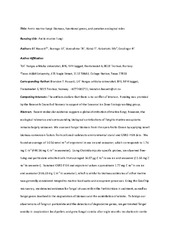| dc.contributor.author | Hassett, Brandon Thomas | |
| dc.contributor.author | Borrego, Eli | |
| dc.contributor.author | Vonnahme, Tobias R. | |
| dc.contributor.author | Rämä, Teppo | |
| dc.contributor.author | Kolomiets, M.V. | |
| dc.contributor.author | Gradinger, Rolf | |
| dc.date.accessioned | 2019-10-22T11:39:18Z | |
| dc.date.available | 2019-10-22T11:39:18Z | |
| dc.date.issued | 2019-02-11 | |
| dc.description.abstract | Recent molecular evidence suggests a global distribution of marine fungi; however, the ecological relevance and corresponding biological contributions of fungi to marine ecosystems remains largely unknown. We assessed fungal biomass from the open Arctic Ocean by applying novel biomass conversion factors from cultured isolates to environmental sterol and CARD-FISH data. <br>We found an average of 16.54 nmol m−3 of ergosterol in sea ice and seawater, which corresponds to 1.74 mg C m−3 (444.56 mg C m−2 in seawater). Using Chytridiomycota-specific probes, we observed free-living and particulate-attached cells that averaged 34.07 µg C m−3 in sea ice and seawater (11.66 mg C m−2 in seawater). Summed CARD-FISH and ergosterol values approximate 1.77 mg C m−3 in sea ice and seawater (456.23 mg C m−2 in seawater), which is similar to biomass estimates of other marine taxa generally considered integral to marine food webs and ecosystem processes. <br> Using the GeoChip microarray, we detected evidence for fungal viruses within the Partitiviridae in sediment, as well as fungal genes involved in the degradation of biomass and the assimilation of nitrate. To bridge our observations of fungi on particulate and the detection of degradative genes, we germinated fungal conidia in zooplankton fecal pellets and germinated fungal conidia after 8 months incubation in sterile seawater. <br> Ultimately, these data suggest that fungi could be as important in oceanic ecosystems as they are in freshwater environments. | en_US |
| dc.description.sponsorship | We would like to acknowledge the funding support provided by UiT - the Arctic university of Norway
and the Tromsø Research Foundation under the project Arctic SIZE, number 01VM/H15. | en_US |
| dc.description | Submitted manuscript version, licensed <a href=https://www.nature.com/nature-research/editorial-policies/preprints-and-conference-proceedings>Natureresearch Preprint Policy</a>. <br>Published version available at: <a href=http://dx.doi.org/10.1038/s41396-019-0368-1>http://dx.doi.org/10.1038/s41396-019-0368-1</a> | en_US |
| dc.identifier.citation | Hassett, B.T., Borrego, E.J., Vonnahme, T.R., Rämä, T., Kolomiets, M.V., Gradinger, R. (2019) Arctic marine fungi: biomass, functional genes, and putative ecological roles. <i>The ISME Journal, 2019</i>, (13), 1484-1496. http://dx.doi.org/10.1038/s41396-019-0368-1 | en_US |
| dc.identifier.cristinID | FRIDAID 1676248 | |
| dc.identifier.doi | 10.1038/s41396-019-0368-1 | |
| dc.identifier.issn | 1751-7362 | |
| dc.identifier.issn | 1751-7370 | |
| dc.identifier.other | https://www.nature.com/articles/s41396-019-0368-1 | |
| dc.identifier.uri | https://hdl.handle.net/10037/16449 | |
| dc.language.iso | eng | en_US |
| dc.publisher | Springer Nature Publishing AG | en_US |
| dc.relation.journal | The ISME Journal | |
| dc.rights.accessRights | openAccess | en_US |
| dc.subject | VDP::Mathematics and natural science: 400::Zoology and botany: 480::Marine biology: 497 | en_US |
| dc.subject | VDP::Matematikk og Naturvitenskap: 400::Zoologiske og botaniske fag: 480::Marinbiologi: 497 | en_US |
| dc.title | Arctic marine fungi: biomass, functional genes, and putative ecological roles | en_US |
| dc.type | Journal article | en_US |
| dc.type | Peer reviewed | en_US |


 English
English norsk
norsk